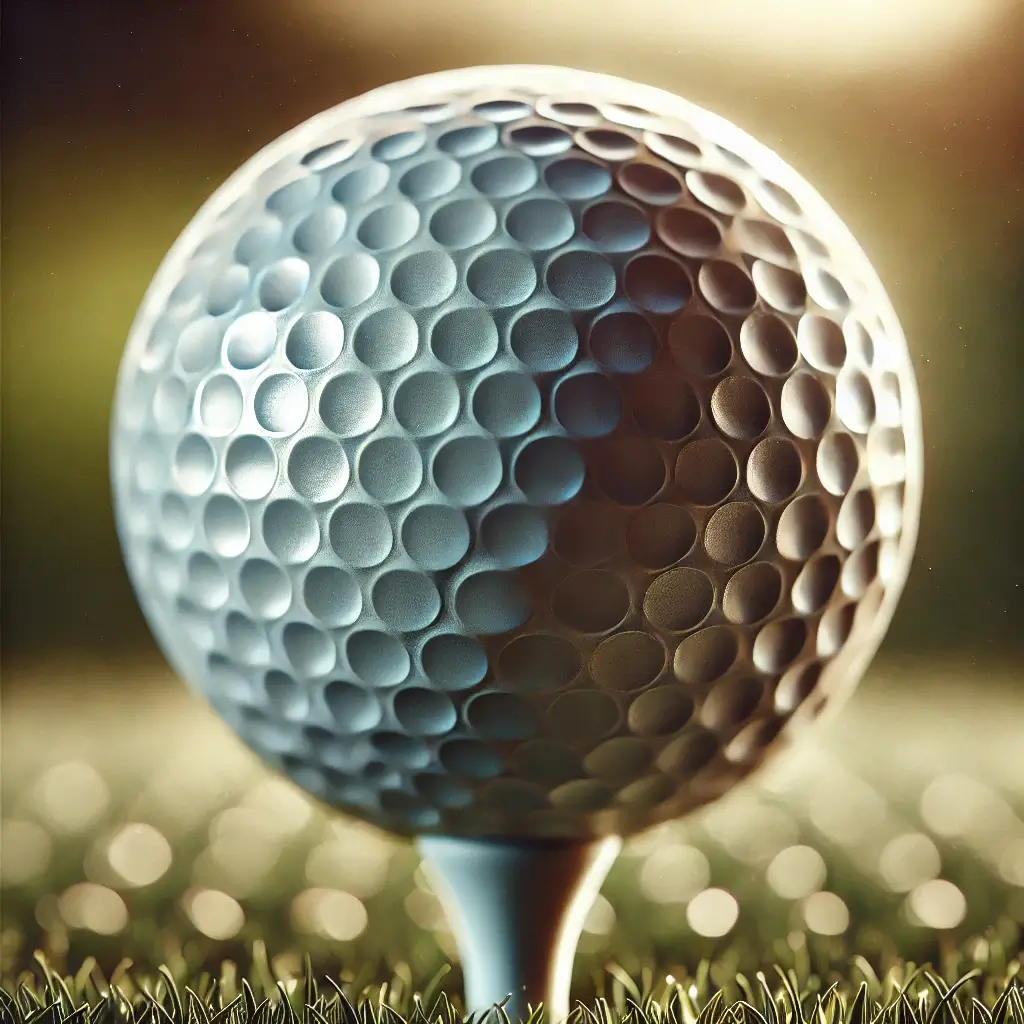Why Golf Balls Have Dimples: A Deep Dive into Aerodynamics
Ever stood on the tee, looked down at that little white ball, and wondered why it’s covered in dents? It seems counterintuitive. Surely, a perfectly smooth ball would fly farther and straighter, right? The truth is precisely the opposite, and the reason is a fascinating story of physics, engineering, and a touch of accidental discovery.
The seemingly simple dimples on a golf ball are a marvel of aerodynamic engineering. They are the single most important feature determining how far and how high a golf ball flies. Without them, the game of golf as we know it would be impossible. A professional golfer’s 300-yard drive would plummet to the ground in less than half that distance.
In this comprehensive guide, we’re going to unravel the science behind golf ball dimples. We’ll explore the critical concepts of drag, lift, and boundary layers, and explain exactly how these little craters manipulate the air to achieve maximum distance and stability. Prepare to see your golf ball not as a simple piece of equipment, but as a sophisticated airfoil designed for peak performance.

The Smooth Ball Paradox: Why Smoother Isn’t Better
To understand why dimples are so crucial, we first need to understand what would happen without them. Imagine a perfectly smooth golf ball. When you strike it, it launches into the air at high speed. As it moves, the air in front of it parts to go around it. This is where the problems begin.
Air, like any fluid, has viscosity. It sticks to surfaces. For a smooth ball at high speed, the air flows smoothly over the front surface in what scientists call a laminar boundary layer. This sounds good, but this layer of air doesn’t have enough energy to stick to the ball’s surface all the way around. About halfway back, it separates from the ball, creating a large, turbulent, low-pressure area behind it. This area is called a “wake.”
Think of it like a boat moving through water. The boat creates a large V-shaped wake behind it. This wake is essentially a vacuum, pulling backward on the boat and slowing it down. The same thing happens to a smooth golf ball in the air. This massive backward pull is known as pressure drag (or form drag), and it’s the primary enemy of distance in golf. It acts like a parachute, robbing the ball of its speed and causing it to fall out of the sky much sooner.
Introducing Aerodynamic Drag: The Unseen Opponent
Drag is the force that resists an object’s motion through a fluid (in this case, air). For a golf ball, there are two main types of drag we care about:
- Skin Friction Drag: This is caused by the friction of the air rubbing against the surface of the ball. A rougher surface generally creates more skin friction.
- Pressure Drag: This is caused by the pressure difference between the front of the ball (high pressure) and the back of the ball (the low-pressure wake). This is the dominant, more powerful type of drag for a blunt object like a golf ball.
A smooth ball has low skin friction but suffers from catastrophically high pressure drag due to its large wake. The genius of the golf ball dimple is that it makes a small sacrifice in skin friction to win a massive victory over pressure drag.
Key Concept: The Wake
A smooth ball creates a large, low-pressure wake that acts like a vacuum, pulling the ball backward and drastically reducing its flight distance. This is called pressure drag.
The Dimple’s Magic Trick: Taming the Airflow
So, how do dimples solve this problem? They perform a bit of aerodynamic wizardry by intentionally making the airflow “messy” in a very specific way.
When a dimpled ball flies through the air, the small craters trip up the smooth laminar boundary layer, churning it into a turbulent boundary layer. This might sound bad—”turbulent” usually has negative connotations—but here, it’s the secret to success. This turbulent layer of air is much more energetic than its smooth, laminar counterpart.
Because it’s so energetic, this turbulent boundary layer is able to “hug” the surface of the golf ball for much longer. Instead of separating halfway around the back, it clings to the ball’s contour almost all the way to the rear. As a result, the low-pressure wake created behind the ball is dramatically smaller—less than half the size of the wake behind a smooth ball.

This massive reduction in the size of the wake leads to a massive reduction in pressure drag. Yes, the dimples slightly increase the skin friction drag because the surface is rougher. However, the reduction in pressure drag is so immense that it completely outweighs the minor increase in skin friction. The net effect is a total drag reduction of up to 50%.
This is the magic of the dimple: it trades a little bit of skin friction for a huge reduction in pressure drag, allowing the ball to retain its velocity for much longer and travel significantly farther.
Generating Lift with Backspin and Dimples
Distance isn’t just about reducing drag; it’s also about creating lift. When a golfer strikes the ball correctly, they impart a significant amount of backspin. This backspin is critical for generating aerodynamic lift, a phenomenon known as the Magnus Effect.
As the ball spins backward, the top surface of the ball is moving in the same direction as the oncoming air, while the bottom surface is moving against it. This causes the air to move faster over the top of the ball and slower underneath. According to Bernoulli’s Principle, faster-moving air exerts lower pressure, and slower-moving air exerts higher pressure.
This pressure differential—low pressure on top, high pressure on the bottom—creates an upward force on the ball: lift. This is the same principle that allows an airplane’s wing to fly.
Where do the dimples fit in? They enhance this effect. The turbulent boundary layer created by the dimples helps maintain the airflow separation that creates this pressure difference, making the lift more consistent and pronounced. A dimpled, spinning ball generates significantly more lift than a smooth, spinning ball, allowing it to stay in the air longer for a towering, majestic ball flight.
The Evolution of the Perfect Dimple
The discovery of the dimple’s benefit was serendipitous. In the mid-19th century, golfers played with “gutta-percha” balls, which were made from the rubber-like sap of a tree. They were perfectly smooth when new. However, players quickly noticed that older, scuffed-up balls with nicks and cuts in them actually flew farther and truer than brand-new ones. It wasn’t long before ball makers started intentionally adding patterns to their surfaces, first with hand-hammered designs and later with intricate molds.
Today, dimple design is a highly precise science. It’s not just about having dimples; it’s about having the right number, size, depth, shape, and pattern of dimples. Companies like Titleist, Callaway, and TaylorMade spend millions on research and development, using supercomputers and wind tunnels to perfect their dimple patterns.
Key factors in modern dimple design include:
- Dimple Count: Most golf balls have between 300 and 500 dimples. While there’s no single “magic number,” the count is a factor in the overall design.
- Dimple Shape: Many modern balls use non-spherical dimples, such as hexagonal or even “dual-dimple” patterns where a smaller dimple sits inside a larger one. This can further optimize airflow.
- Depth and Edge Angle: The steepness of the dimple’s walls and its overall depth have a significant impact on how effectively it creates turbulence.
- Symmetry and Coverage: The goal is to cover as much of the ball’s surface as possible with a repeating, symmetrical pattern to ensure consistent flight no matter how the ball is oriented.
It’s a Complete System: How Your Gear Works Together
It’s crucial to remember that the golf ball is just one part of a complex system. The most aerodynamically perfect ball won’t reach its potential if the other components of your equipment aren’t optimized for your swing. The club head imparts the initial speed and spin, and the shaft transfers your energy. But equally important is your connection to the club itself. A secure, comfortable connection to the club is paramount for consistency and power transfer. This is why having one of the best driver grips suited to your hands and playing style can make a surprising difference in your ability to control the clubface and deliver the kind of strike that lets the ball’s aerodynamics do their job.
As an Amazon Associate, we earn from qualifying purchases. The product selections below are curated by our editorial team to help you find the best gear for your game.
Top-Tier Golf Balls: Where Engineering Meets Performance
Understanding the science is one thing, but seeing it in action is another. Here are a few examples of popular, high-performance golf balls on the market today, each featuring its own unique and highly engineered dimple technology.

Titleist Pro V1
The gold standard for many golfers. The Pro V1 features a spherically-tiled 388 tetrahedral dimple design. This pattern is engineered to provide a penetrating ball flight for long distance with very consistent control, making it a favorite among tour professionals and amateurs alike.
Check Price on Amazon
Callaway Chrome Soft
Callaway’s signature is their HEX Aerodynamics pattern. Instead of round dimples, they use a tubular lattice of hexagons. This design reduces drag for longer, more stable flights, especially in windy conditions, while providing exceptional feel and greenside control.
Check Price on Amazon
TaylorMade TP5
The TP5 family uses a “Tour Flight Dimple Pattern.” This unique 322-dimple design features shallower dimples with steeper walls. This combination is engineered to reduce drag during ascent and increase lift on the way down, maximizing carry distance for a wide range of swing speeds.
Check Price on AmazonFrequently Asked Questions About Golf Ball Dimples
What would happen if you hit a smooth golf ball?
A PGA Tour pro hitting a smooth golf ball with a driver would see their distance cut nearly in half. The ball would fly with an unstable, knuckleball-like trajectory and drop out of the air very quickly due to the massive amount of pressure drag created by the large wake behind the ball.
Do all golf balls have the same number of dimples?
No. The number of dimples varies widely between manufacturers and models, typically ranging from 300 to over 500. However, modern golf ball design focuses less on the exact number and more on the overall pattern, depth, shape, and surface coverage to achieve specific aerodynamic properties.
Do dimples affect putting?
On the green, dimples have a negligible effect. The speed of a putt is far too low for the aerodynamic properties of dimples to come into play. A ball’s roll is dictated by its balance, roundness, and the quality of the green’s surface, not its dimples.
Can golf ball dimples wear out?
Yes. A significant scuff or cut on a golf ball can disrupt its dimple pattern and negatively affect its aerodynamics. A deep scratch can alter the airflow, potentially causing the ball to fly erratically. This is why professionals often change balls after playing a hole with a cart path or tree encounter.
Why don’t other sports balls, like baseballs, have dimples?
Different sports have different aerodynamic goals. A baseball’s raised stitches are crucial for a pitcher’s ability to throw curveballs and sliders by creating asymmetric airflow. A soccer ball’s panels and texture help it swerve in the air. Dimples are a specific solution for a specific problem: maximizing the distance and stability of a small, fast-moving sphere hit with backspin.
Conclusion: A Small Feature with a Monumental Impact
The next time you place a golf ball on the tee, take a moment to appreciate the incredible engineering nestled in its surface. Those simple dimples are not just for show; they are a perfectly designed solution to a complex physics problem. By cleverly turning a smooth airflow into a turbulent one, they drastically reduce drag, enhance lift, and allow the ball to fly hundreds of yards farther than would otherwise be possible.
From an accidental discovery on scuffed-up gutta-perchas to the computer-optimized patterns of today, the evolution of the golf ball dimple is a testament to human ingenuity. It’s a quiet reminder that in golf, as in science, sometimes creating a little bit of controlled chaos is the key to achieving perfection.

